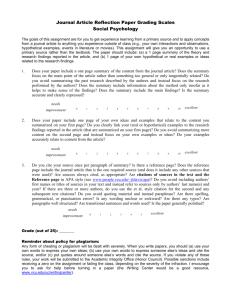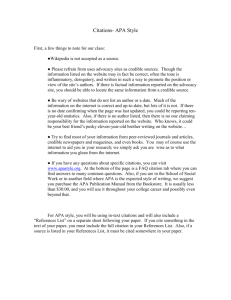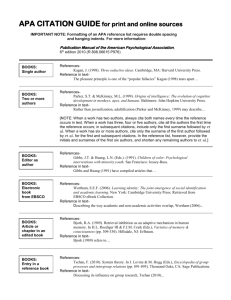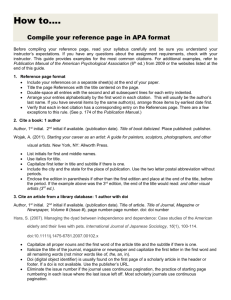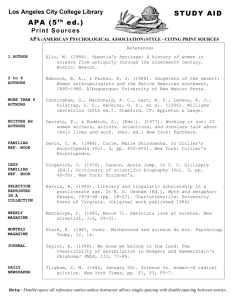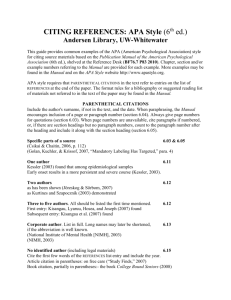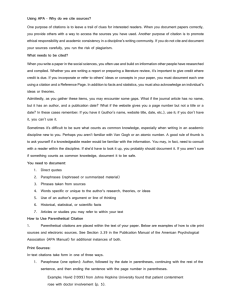APA Formatting / Using Professional Literature
advertisement
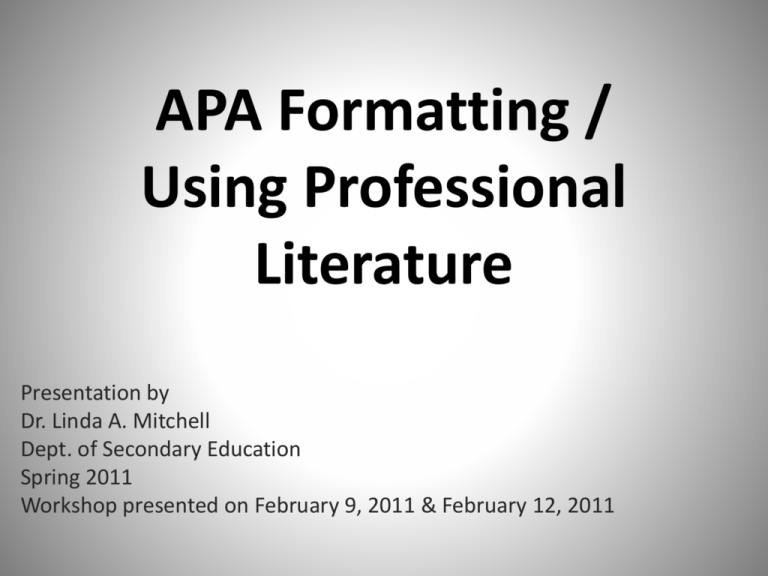
APA Formatting / Using Professional Literature Presentation by Dr. Linda A. Mitchell Dept. of Secondary Education Spring 2011 Workshop presented on February 9, 2011 & February 12, 2011 APA Formatting: 6th Edition • The basics: – Get a manual: APA Publications Manual of the American Psychological Association, 6th Edition. – Set it up so you can use it efficiently – Make sure you know how to use your computer’s software so that you can make the appropriate adjustments to your document. • If you are unsure about how to do something learn to use the ‘Help’ menu and if necessary look for assistance on the Internet. Basic paper set-up • Times New Roman font – Never use a compressed font size • 12-point font size • Double-space all lines of text – The only time single or 1 ½ spacing might be used is in a table or figure. • All margins should be uniform and at least 1” • Do not hyphenate words at the end of a line and do not justify lines • Indent the first line of all paragraphs. Header and page numbers • Use the ‘Header’ function of your word processing program to create headers and page numbers on your paper. Title Page • Information on the Title Page should be centered • Information should include: – – – – Title of paper Author(s) School affiliation (brief) Author’s note (not usually needed for papers) • In place of the author’s note, students will often put information such as class title, professor/instructor name, title of the assignment, and date of assignment submission. Headings • Headings come in several levels and should be used sparingly, but appropriately. • Headings should help your reader understand what you are writing about better and how it is organized. They are not there to keep you from having to go to the trouble of structuring your paper properly or write appropriately. • Levels: Level 1: Centered, Boldface, Uppercased and Lowercase Heading Level 2: Flush Left, Boldface, Uppercase and Lowercase Heading Level 3: Indented, boldface, lowercase paragraph heading ending with a period. Level 4: Indented, boldface, italicized, lowercase paragraph heading ending with a period. Level 5: Indented, italicized, lowercase paragraph heading ending with a period. Using Quotes • If you are quoting directly, you must check carefully for accuracy. • Do not make corrections to the original text or, if you absolutely must, look up the requirements for doing so. • You can change the first letter of a quote to uppercase or lowercase as appropriate for the placement and end punctuation may be changed to fit the sentence. • If you omit part of a quote in the middle, you must include three spaced ellipsis points (. . .) where you omitted the material. • If you must add something (only do this because it is truly needed for clarity) use brackets [ ] not parentheses. • If there is a citation within the quote you are using – leave it in and you do not have to include a reference to that citation unless you also cite that source somewhere else in your paper. Including lists • Use lists sparingly • When a list is the best and most effective way to convey information you should use bullets and indent the list. • Do not number a list unless you intend for the list to imply priority, rank, or status, since this is often the implied meaning of a numbered list. That is why it is best to use bullets. • Use standard, round or square bullets for the list Including tables & graphics • Often a table, graph, or other graphic can portray a point you need to make much more clearly than many paragraphs. • When this is true you need to carefully review the requirements for including tables and graphics. • All must have/do the following: – – – – – Title Number Description/notes Follow the guidelines for that particular type of graphic Must clearly advance understanding of the material you are presenting. When to cite • When you use information from another source you have to cite that source in your work. • Using information means that you quote from or that you get information, ideas, or inspiration from that source • Sources can include: – – – – – Printed books and journals Online resources Audiovisual media Personal communications Any other resource that you use for information or inspiration General citation information • Always cite authors names in the exact order that they are listed in the work. NEVER rearrange them or alphabetize them. • APA uses surname (last name), first initial, and middle initial if the author prefers. – This is done to help cut down on gender and other types of bias In-text citations • Always cite your resource(s) in the body of your paper where you use the resource. – If you use several resources as inspiration for one paragraph, you should cite all of them at the end of the paragraph in a parenthetical reference. – If you quote a resource directly you should place the in-text citation in the appropriate place with the quote. – Other resources you use as the inspiration for a paragraph or passage can be placed at the beginning, the end, or within the paragraph in several different ways. – If you are using more than one source within an in-text citation you list the sources alphabetically by the first author’s name as they are listed with the title Types of In-text citations • One author: – Smith (2011) wrote the text that ….. – …….completed the written text (Smith, 2011). – In 2011, Smith wrote the text that…… • Two authors: – both authors’ names are listed each time with an ampersand [&] or and between them and citations are treated just like one author citations. Types of In-text citations • 3 - 5 authors [pg. 177]: – List all authors names the first time the work is cited; use the first author’s name and et al. for all citations after that. – Examples: • Smith, Jones, Hayes, and Allen (2011) wrote the text that ….. – Smith et al. (2011) wrote the text that….. • ……. the written text (Smith, Jones, Hayes, & Allen, 2011). – ……. the written text (Smith et al., 2011). • In 2011, Smith, Jones, Hayes, and Allen wrote the text that…… – In 2011, Smith et al. wrote the text that…… • Six or more authors: – For all citations list only the surname of the first author, et al., and the year of publication. – If this creates a situation where more than one resource is going to be cited the same you will have to list the 2nd or 3rd authors as well until you have a distinct citation for that resource. – Example: Spellman, Mynth, Jones, Hayes, Allen, and Lei (2011) would be.. • Spellman et al. (2011) • (Spellman et al., 2011) • In 2011, Spellman et al. found that ……. Types of In-text citations • Works with no author: – – – – This includes web pages (we will discuss entire websites later) that do not have an author listed Use the first few words of the title or entry and the year. Use double quotation marks and italicize the ‘title’ if it is a periodical, book, brochure, or report. Example: • • “Groups as Authors,” (2011) finds that …. (“Groups as Authors,” 2011) finds that… • Author is a group: – If the group name is short, write it for each citation and treat citations as a one author text – If the group name is long and cumbersome you can abbreviate: • Abbreviate only if: 1. 2. 3. The abbreviation would be understandable and allow the reader to find the work in the resources list Only after writing the complete group name and showing the abbreviation in parentheses after it for the first citation Example: » College of Education and Professional Studies (CEPS, 2011) found that all students in the group…… • CEPS (2011) went on to find that some students……. » …according to the most recent data (College of Education and Professional Studies [CEPS], 2011). » …despite the earlier suggestion (CEPS, 2011). References • Pay close attention to form • Remember to use only surname and initials • Use the ampersand [&] when listing authors • Pay close attention to capitalization as this is very tricky • Be sure to pay attention to your word processor’s Auto Correct. It will do things that can mess up your formatting: – Automatically capitalizing after every period • When Auto Correct ‘fixes’ a problem that isn’t really a problem you can either [Control – Z] or [Edit – Undo] to make the text go back to the way you typed it. – Making all web addresses blue and underlined • When this happens you may have to tell your computer to remove the hyperlink or you may be able to highlight and make the text black with no underline. Journals • Journal articles may be found electronically or in hard copy [paper] • Journal article, with DOI, 7 or less authors (list all authors) – • Journal article, without DOI, 7 or less authors (list all authors) – • Simpson, K. M., dePallo, J. L., & Lee, M. C. (2011). How to cite your resources. Journal of Cited Resources, 1(2), 4765. doi:10.1111111111 Simpson, K. M., dePallo, J. L., & Lee, M. C. (2011). How to cite your resources. Journal of Cited Resources, 1(2), 4765. Journal article, 7 or less authors (list all authors), retrieved electronically and no DOI available: – Simpson, K. M., dePallo, J. L., & Lee, M. C. (2011). How to cite your resources. Journal of Cited Resources, 1(2), 4765. Retrieved from http://www.apastyle.org • • Note that you do not need to identify the date that you retrieved an article or other information from the Internet UNLESS it is likely to change over time. A journal article will not change. Wiki’s, webpages, blogs, etc. will so be sure you know the difference. More than 7 authors: list the first six, put . . . then list the last author and go on with the reference. [pg. 198] Digital Object Identifier [DOI] • Most new electronic material will have a DOI and if there is one you should always list it. • Older material may not have a DOI or it may not be listed anywhere that you can find. • There are a several ways to find the DOI: Often the DOI is listed in the citation where you find the article: Sometimes the DOI is listed on the article itself or in other places: DOI is embedded and not clearly labeled in the citation. On the journal website where I go to retrieve the article I find the DOI clearly listed. News articles • Online newspaper article – Mitchell, L. A. & Kohl, J. M. (2011, February 1). The importance of citing your sources. The New Times News. Retrieved from http://www.apastyle.org • Newspaper article – Mitchell, L. A. & Kohl, J. M. (2011, February 1). The importance of citing your sources. The New Times News. pp. A3, A6. Books • Keep in mind that the point of a reference is to give credit and ensure that someone else can find this resource if they should want to. • Depending on where you gain access to the book you may need to provide a web address or DOI information. • If all you are using is a chapter from an edited book, you must provide that information as well. • Listing authors is the same as for journals Books • Examples: – Standard print book: • Houge, J. A. (2011). How to cite your sources. New York: Pearson. – Book only available online: • Houge, J. A. (2011). How to cite your sources. Retrieved from http://www.apastyle.org. • Houge, J. A. (2011). How to cite your sources. doi: 10.1111111111 – Book that has an editor instead of author(s): • Houge, J. A. (Ed.). (2011). How to cite your sources. New York: Pearson. Books • Examples: – Chapter in a book: • You list the chapter information and then the book information much as you would have in a book reference. The main differences are that the publish date gets moved to the chapter info instead of the book info and you include the pages that you used from the book. • Nettles, S. T. & Brown, H. W. (2011). When good citations go bad. In Houge, J. A. (Ed.). How to cite your sources (pp. 231-260). New York: Pearson. • Nettles, S. T. & Brown, H. W. (2011). When good citations go bad. In Houge, J. A. & Smyth, R. L. (Eds.). How to cite your sources (pp. 231260). doi:10.1111111111 Books • Examples: – E-Books, such as for the Kindle: • For the reference list entry, you’ll need to include the type of e-book version you read (two examples are the Kindle DX version and the Adobe Digital Editions version). In lieu of publisher information, include the book’s DOI or where you downloaded the e-book from (if there is no DOI). (information retrieved from http://blog.apastyle.org/apastyle/2009/09/how-do-i-cite-akindle.html): – For additional information go to the APA Blog Home on the APA website listed throughout this PowerPoint. • Gladwell, M. (2008). Outliers: The story of success [Kindle DX version]. Retrieved from Amazon.com • Brill, P. (2004). The winner’s way [Adobe Digital Editions version]. doi:10.1036/007142363X Audiovisual • The types of audiovisual media that is available and that writers may need to use changes regularly. • Be aware of exactly what you are using before you decide how to cite the source and provide the reference. – Example: If you are using a song as part of a work you are doing, you need to determine how you are using that song. Is it the lyrics or a musical rendition of the song that you are using? Making this determination is key to determining how you will list and cite the resource. – Some resources, such as podcasts and radio programs, would seem as if they would always be listed as the audio or audiovisual media only, since this is the media in which they were created, but be careful of even this assumption. If you actually access the information from a transcript and not from the actual media and/or if you retrieved a transcript to help you with your work, then you need to list that transcript. • Remember sometimes transcribers make mistakes and you don’t want to pretend information came directly from a radio broadcast when it came from a transcript and find out too late that if you had been listening instead of reading your info would have been different. Audiovisual [pp. 209-10 and on APA website] • Citing an entire website and not a page in the website: – List the website name and the web address. • ALEX: Alabama Learning Exchange (http://alex.state.al.us/index.php) • Citing a web page or article found on a website: – These are treated much like other citations/references already discussed. – When in doubt – look it up to be safe. ____________ Still have questions? www.apastyle.org APA’s FAQ’s are very helpful In addition to the APA FAQ section, you should always look in the APA Blog when there is a question about formatting that you can’t find the answer to anywhere else. Often these are newer issues and the blog is the perfect place to find the answer or ask a question. Using Professional Literature • Usually professors will break professional literature into two categories: – Scholarly or Research literature – Practitioner literature • Although there is a lot of other literature available, dividing by these two categories will take care of the majority of what you will use for work in university courses. Scholarly/Research Literature • This is literature written for the purpose of discussing some type of research. • These pieces are usually peer reviewed. – This means that before they were accepted for publication a group of specialists in that specialized field reviewed the work and attempted to ensure that: • The research was conducted ethically and in an appropriate manner • The data was analyzed appropriately • The study findings are determined in ways that are consistent with acceptable norms in the field and/or in scholarly research as a whole • The research topic is of great enough importance that it deserves recognition and debate within the scholarly community. Scholarly/Research Literature • This type of literature will usually have several different parts to the manuscript including: – A review of literature, – Description of the study and participants, – Description of the ways data was collected and analyzed, – Findings from the study, – Conclusions the researcher(s) believe can be drawn from the findings. Scholarly/Research Literature • When reading scholarly literature it is important to: – Take good notes – Make sure you understand the basic terms the researcher is using or look them up if you don’t – Be willing to go back to a previous part of the study and reread if you get to the conclusions and there seems to be a disconnect. Researchers sometimes reach conclusions that others find are not supported so don’t assume that the conclusions a researcher puts in his or her paper are correct. You can question if you have a good reason. Practitioner Literature • This is literature that was written for the purpose of helping individuals in a specific field. • This literature may be based on: – Research – Best Practices – Opinions – Examples – Many other reasons someone might want to write a piece of literature for someone else’s use. Practitioner Literature • Examples of Practitioner Literature include, but are not limited to, articles written to: – Tell practitioners how to accomplish a specific task or achieve a goal – Tell practitioners how someone else did something – Explain best practices – Explain new practices or technologies – Provide editorial or opinion on important issues – Debunk untrue work or move practitioners away from practices that are not ‘best’ • When choosing whether or not to use a piece of practitioner literature, you must carefully consider: – The source (the journal it is published in) – The content (is it quality work?) – The author(s). You should find out who the author is and what his/her qualifications are, at a minimum. How do you choose? • When writing for an assignment in a class it is best to simply ask. • If you can’t ask or you are just unsure, err on the side of caution and use only scholarly/research articles from peerreviewed journals. • If the choice is yours, you may want to divide your work between the two but there are few times when you should have less than half of your resources that are not scholarly literature. • When you are doing a true research paper, it is best to have mostly scholarly literature as your references. References Information for this presentation was obtained from the following sources: APA Style Website. (http://www.apastyle.org/index.aspx). EbscoHost Search. http://web.ebscohost.com.lib-proxy.jsu.edu/ehost/detail?hid=9&sid=e60f82006ad2-4422-ad954d1114965d26%40sessionmgr12&vid=5&bdata=JnNpdGU9ZWhvc3QtbGl2ZQ%3d%3d#db=aph&AN =44653485 . Retrieved February 2, 2011. EbscoHost Search. http://web.ebscohost.com.lib-proxy.jsu.edu/ehost/detail?hid=9&sid=e60f82006ad2-4422-ad954d1114965d26%40sessionmgr12&vid=13&bdata=JnNpdGU9ZWhvc3QtbGl2ZQ%3d%3d#db=eric&A N=EJ905901. Retrieved February 2, 2011. Journell, W. (2011). Standardizing citizenship: the potential influence of stat curriculum standards on the civic development of adolescents. Political Science and Politics, 43(2). doi:10.1017/S1049096510000272 Publication Manual of the American Psychological Association, 6th Edition (2009); APA Publishing, Washington DC. Dr. Linda A. Mitchell Assistant Professor Department of Secondary Education Ramona Wood Building, Office A-2 Email: lmitchell@jsu.edu Wimba: l_mitchell Phone: 256-782-5181

